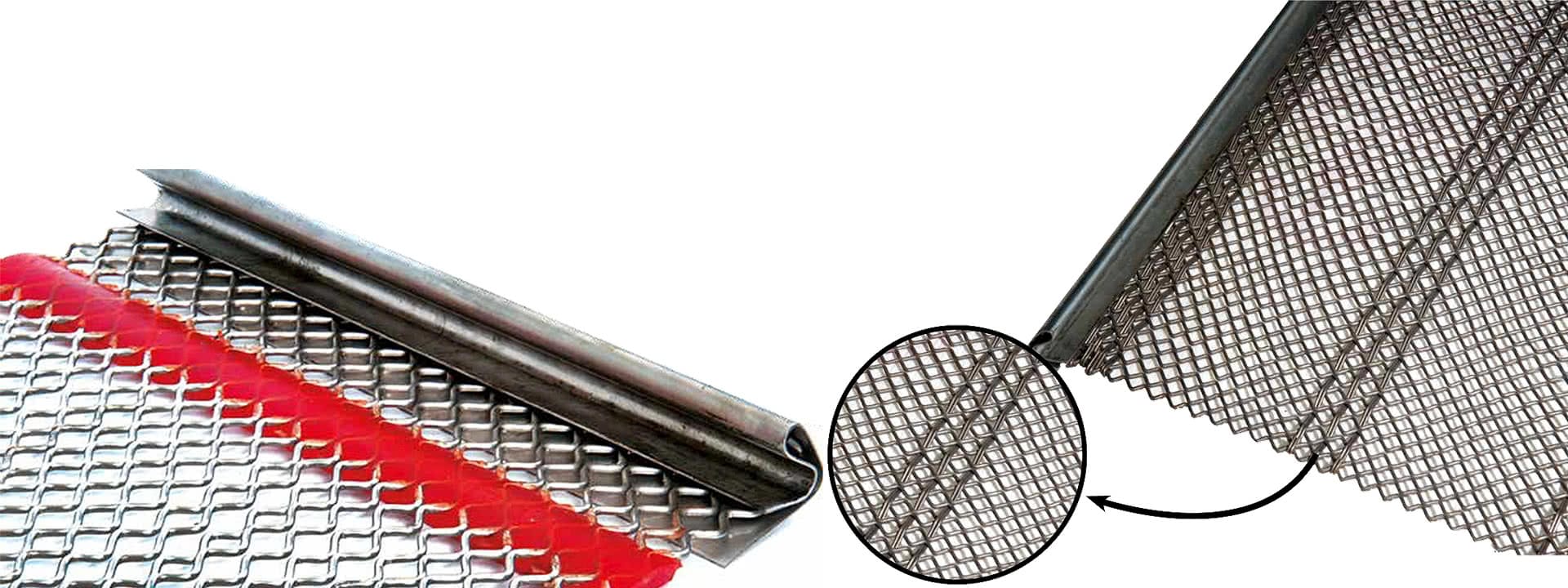ELIMINATE CLOGGING AND BLINDING
Anti-clogging screen panels are a specific type of screening media with unique self-cleaning properties. Polyurethane, rubber or wire wefts connect independent wires to each other with a step up to 300mm (12”). As a result, this type of flexible connection allows the wires to vibrate freely. This vibration and mesh flexibility prevents fine particles from sticking to the mesh and therefore solves potential clogging and blinding problems. Regardless of the vibrating screen type, proper tensioning must be applied when fitting flex anti-clogging screens.
SOLVES BLINDING AND PEGGING
Anti-clogging screens are becoming more and more popular. It is a universal solution for blinding and pegging while allowing for perfect sizing of material. In addition, this type of screening media helps to increase the screening area. Moreover, flex anti-clogging screen mesh can provide perfect sizing for coal, minerals and limestone.
PERFECT SOLUTION FOR FINE SCREENING
Dry screening of fines can be rather hard, especially when the material is slightly wet. Fine particles stick to the wires and form lumps which block the screen openings and decrease the screening area. Fortunately, S-type, D-type and Piano type anti-clogging screens solve these problems as the wires in these panels vibrate freely during operation.
HIGH GRADE HIGH-CARBON STEEL
Not all wires are made the same. To ensure the highest quality and compliance we use only DIN 17223 Grade A steel in our screen panel manufacturing. For stainless steel products we use AISI 304 316 309 standards. Other standards can be used for specific individual applications.
VARIABLE SHAPES AND SIZES
We manufacture and supply anti-clogging screen panels with different sizes, shapes, patterns and apertures.
Polyurethane is widely used in screening applications as it is highly resistant to abrasion. Cast polyurethane strips form necessary connections in anti-clogging screen panels. PU is flexible. Since the wires are connected with only a few strips throughout the width of the screen, it allows the wires to flex easier and vibrate. This movement helps to shake off material from the mesh thus improving self-cleaning properties. In addition, it minimises the pegging as wires can slightly open and allow stuck material to pass through. Polyurethane connections are also necessary for the additional installation of declogging rods that are used to further improve declogging and self-cleaning characteristics. Declogging rods bounce on the PU strips and help shake off the stubborn sticky material. Available patterns are: S-type, D-type and Piano type.
Anti-clogging screens can be manufactured with woven wire strips instead of polyurethane. Since polyurethane is more expensive, this type of anti-clogging screen is more economical but offers the same anti-clogging and self-cleaning properties. Since there are just a few weaves for the entire width of the screen the wires vibrate freely and shake off sticky material. It also minimises the pegging as wires can slightly open and allow stuck material to pass through. Available patterns are: D-type.
Declogging rods have been developed to further improve the self-cleaning properties of anti-clogging screens. Declogging rods bounce on the PU strips and create additional shock that helps to shake off stubborn sticky material from the panels. Declogging rods can be connected in multiple parts to completely cover the screen area.
- Stable operation
- Lower wear compared to conventional steel woven wire mesh
- High tensile strength
- Various opening sizes
- DIN 17223 Grade A Steel
- AISI 304 316 309 Stainless Steel
- Different hooks available
- Cost Effective
- Anti-Clogging properties
- Self-Cleaning properties
- Larger screening area
- Longer service life
- High Efficiency
- Highly resistant to abrasion, wear and tear
- Resistant to corrosion
- Shorter cleaning down-times
- Wide range of applications
- Square hole shape (D-type)
- Screening
- Sizing
- Separating
- Grading
- Shifting
- Washing
- Aggregate Processing
- Washing Applications
- Cement Manufacturing
- Asphalt Plants
- Mining Applications
Our steel meshes are manufactured from high-carbon steel in accordance with DIN EN ISO 16120-2:2001 C66D, DIN EN ISO 16120-P2 C52D, DIN 17223 Grade A Steel, SAE J403:2009 1010. Steel composition:
| C | 0.40 | 0.75 | |||||||||||||||||||||||||||
| MN | 0.5 | 0.90 | |||||||||||||||||||||||||||
| SI | 0.15 | 0.40 | |||||||||||||||||||||||||||
| P | MAX | 0.025 | |||||||||||||||||||||||||||
| S | MAX | 0.025 |



 Vibrating Screen Accessories
Vibrating Screen Accessories
 Polyurethane Screens
Polyurethane Screens
 Woven Wire Screens
Woven Wire Screens
